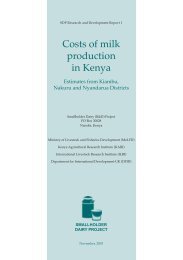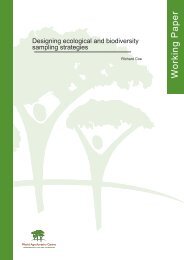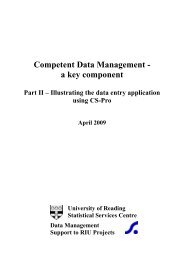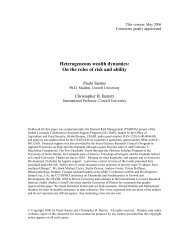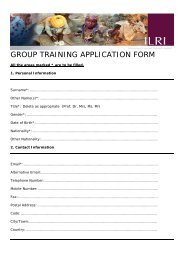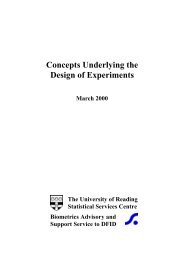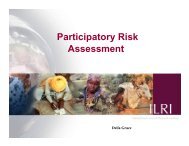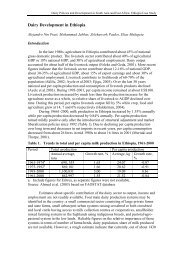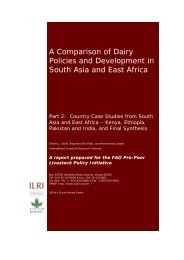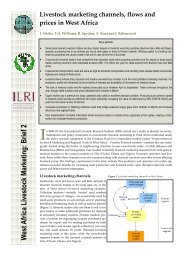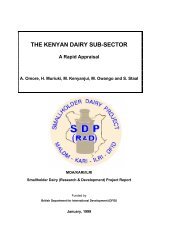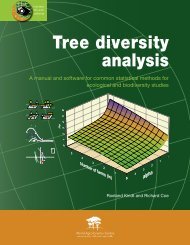Improvement of Livestock Production in Crop-Animal Systems in ...
Improvement of Livestock Production in Crop-Animal Systems in ...
Improvement of Livestock Production in Crop-Animal Systems in ...
You also want an ePaper? Increase the reach of your titles
YUMPU automatically turns print PDFs into web optimized ePapers that Google loves.
Goats outnumber sheep and are found ma<strong>in</strong>ly <strong>in</strong> the ra<strong>in</strong>fed lowlands and uplands <strong>of</strong> central Myanmar,where they are valued as a source <strong>of</strong> <strong>in</strong>come and for meat. The <strong>in</strong>digenous goats have also been <strong>in</strong>fluencedby imports <strong>of</strong> Indian breeds, ma<strong>in</strong>ly the Jamnapari from northern India. The goats are mostly sold bymiddlemen to meet the demand for goat meat <strong>in</strong> the cities <strong>of</strong> Yangon and Mandalay. Sheep are found <strong>in</strong> theupland areas <strong>of</strong> northern Myanmar. The Corriedale breed was <strong>in</strong>troduced from Australia for cross<strong>in</strong>g withthe <strong>in</strong>digenous sheep, but with little success.Pig and poultry production is based on exotic breeds such as the large white, landrace and Berkshire(pigs); and the Rhode Island red and white leghorn (chicken). For fatten<strong>in</strong>g, the large white and Berkshirecrosses are favoured by farmers and animals are slaughtered at about 100 kg liveweight.The diverse animal resources have not been characterised adequately <strong>in</strong> genetic terms and, as aconsequence, the productive potential <strong>of</strong> <strong>in</strong>dividual breeds rema<strong>in</strong>s largely unknown. This is an area that isfundamental to animal improvement <strong>in</strong> Myanmar.<strong>Animal</strong> production systemsRum<strong>in</strong>ants are managed ma<strong>in</strong>ly <strong>in</strong> extensive systems. The only exception to this is dairy production on statefarms, where stall feed<strong>in</strong>g <strong>of</strong> improved grasses and concentrates is practised. Pig and poultry production systemsare <strong>in</strong>tensive state-farm operations, ma<strong>in</strong>ly <strong>in</strong> the peri-urban areas. These commercial units are large and arebased on imported breeds, concentrate feeds and disease control. The state farms have the objectives <strong>of</strong> supply<strong>in</strong>gweaners to farmers for breed<strong>in</strong>g purposes and produc<strong>in</strong>g animals for pork. Manure is a valuable output fromanimal production and is used by farmers for fertilis<strong>in</strong>g crops. Poultry litter is also used for aquaculture.Feed resourcesNative grasses and crop residues form the ma<strong>in</strong> roughage sources for rum<strong>in</strong>ants. On state farms, Brachiariaspp are commonly grown, but <strong>in</strong>adequate use is be<strong>in</strong>g made <strong>of</strong> other more productive species such as Napierand Gu<strong>in</strong>ea grass. Little use is made currently <strong>of</strong> herbaceous legumes or multipurpose trees.The most important crop residues for rum<strong>in</strong>ants are rice straw, maize stover and mungbean stover. Inaddition, several important prote<strong>in</strong> sources are produced such as sesame cake, peanut meal, coconut cake,cottonseed cake and rice bran. The latter is used for all species, <strong>in</strong>clud<strong>in</strong>g fish, and is the ma<strong>in</strong> prote<strong>in</strong> sourcefor pigs, poultry and dairy cattle. Broken rice is also important and is used for both rum<strong>in</strong>ants andnon-rum<strong>in</strong>ants.There are five feed mills <strong>in</strong> the country which produce concentrate feeds for pigs, poultry and dairycattle. However, all these mills are produc<strong>in</strong>g at 50% below capacity, and no clear quality-control measuresexist to protect the purchaser.<strong>Animal</strong> health and diseases<strong>Animal</strong> diseases are not considered to be the major constra<strong>in</strong>t to production. Foot-and-mouth disease andhaemorrhagic septicaemia are the most important diseases <strong>in</strong> large rum<strong>in</strong>ants. Anthrax also occurs <strong>in</strong> cattle.The need for more vacc<strong>in</strong>es for foot-and-mouth disease and haemorrhagic septicaemia was emphasised.Disease-free zones <strong>in</strong> the western part <strong>of</strong> the country are be<strong>in</strong>g contemplated. R<strong>in</strong>derpest was reported last<strong>in</strong> 1957. Chicken are regularly vacc<strong>in</strong>ated aga<strong>in</strong>st Newcastle disease.There is limited research on Gumboro, microplasmosis and <strong>in</strong>fectious bronchitis <strong>in</strong> poultry, andtransmissible enteritis <strong>in</strong> pigs. It was <strong>in</strong>terest<strong>in</strong>g to note that an effective live vacc<strong>in</strong>e for haemorrhagicsepticaemia has been developed locally as a nasal spray. Tests have <strong>in</strong>dicated clearly that the nasal route isa more effective pathway than the systemic one and, more importantly, its effectiveness can last for up to oneyear compared to six months for the latter. In addition, vacc<strong>in</strong>es are produced for redwater, anthrax andfoot-and-mouth disease <strong>in</strong> cattle and buffaloes, sw<strong>in</strong>e fever <strong>in</strong> pigs, anthrax <strong>in</strong> goats and sheep, and Newcastledisease, fowl pox and Gumboro <strong>in</strong> poultry.



